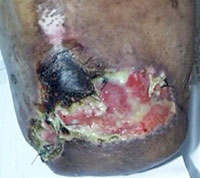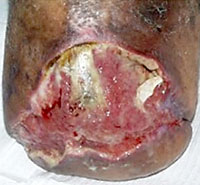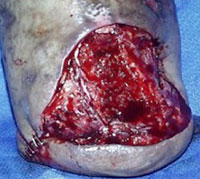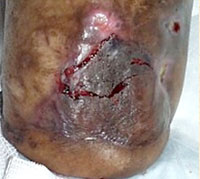
|
A 53-year-old man had below knee
amputation for diabetic vascular complications.
Most surgeons seeing a stump complication indiscriminately
do an above knee amputation, most of which are unnecessary.
This wound had granulation tissue and other wound
module elements indicative of sufficient circulation
and competence to heal. Necrosis was a consequence
of avoidable technical factors. With patience, good
wound care, and suitable surgery, this below knee
amputation can be preserved and healed.
|
 |
|
After a period of debridement
and good daily care, the wound met criteria for
reclosure. Note the exposed necrotic tibial surface,
which needed excision.
|
 |
|
In surgery, the prepared wound
was excised and anterior tibia was decorticated.
For closure, the conventional choices of grafts
and flaps were either not available or not likely
to work. Had they been the only choices, higher
amputation might have been considered. However,
Integra solved this problem with no risk to the
stump or to the patient. Integra is not an alternative
nor substitute for classic surgery, but rather an
independent surgical modality that works where conventional
methods cannot.
|
 |


|
The stump healed. Throughout the
reconstruction, a rigid posterior platform splint
maintained an extended knee, permitting expeditious
rehabilitation. This image is three months after
skin grafts. The patient had fallen, causing a tangential
avulsion laceration of the newly healed epidermis.
Treated and re-healed like any similar laceration.
This minor traumatic injury illustrates that the
Integra wound requires some time to develop sufficient
strength to bear the requirements of daily life.
Appropriate caution and care should be taken for
several months after reconstruction.
|
 |
Cases
Courtesy of:
Marc E. Gottlieb, M.D., Jennifer Furman
Journal of Burns and Wounds, Vol 3, #2